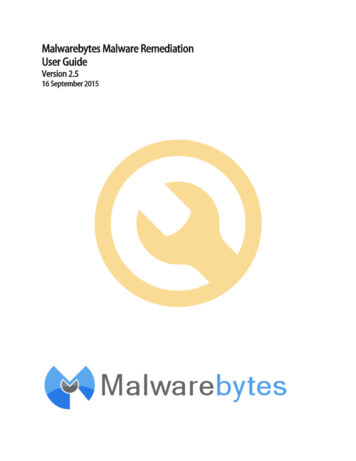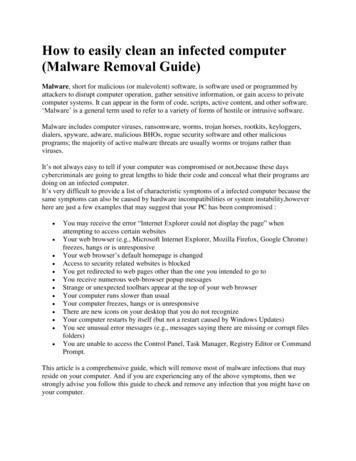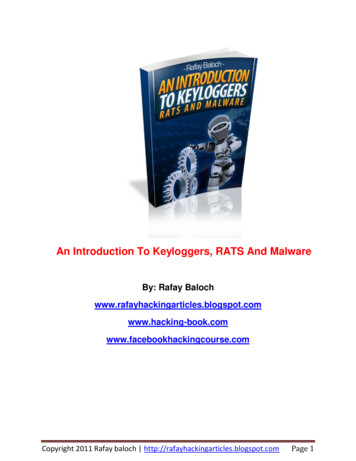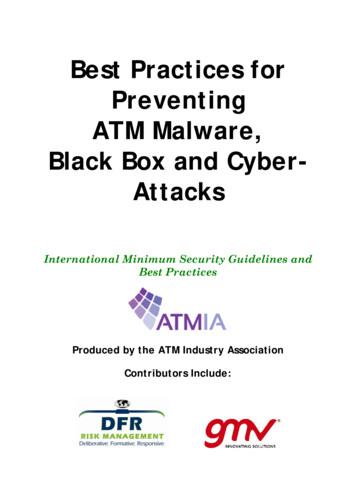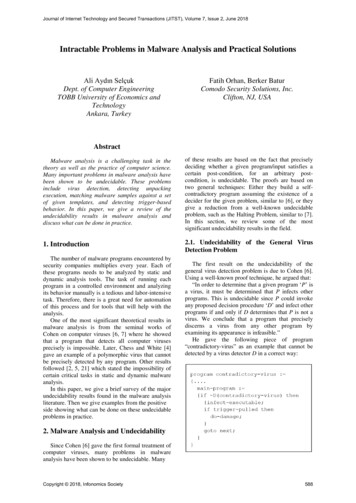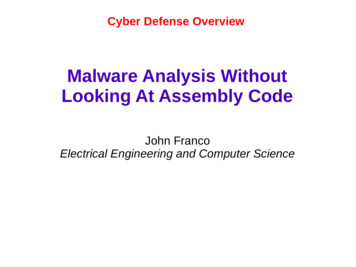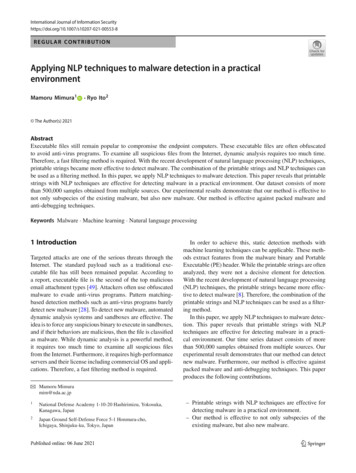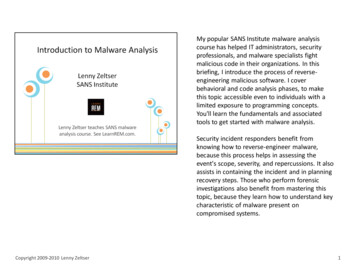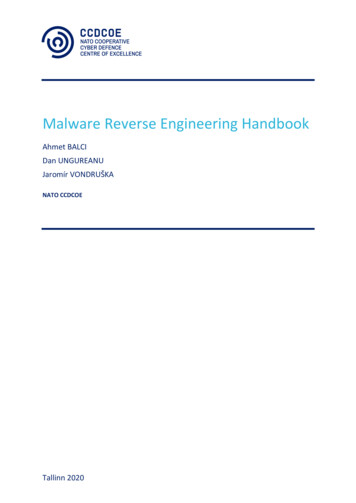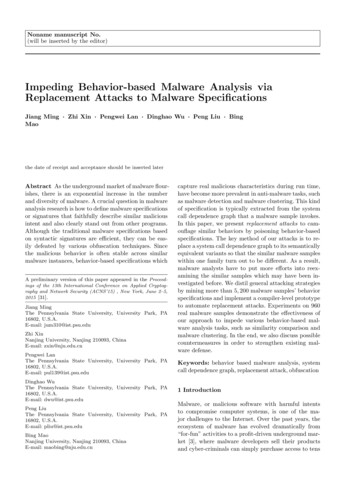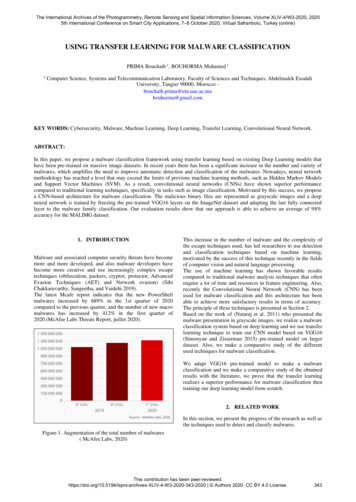
Transcription
The International Archives of the Photogrammetry, Remote Sensing and Spatial Information Sciences, Volume XLIV-4/W3-2020, 20205th International Conference on Smart City Applications, 7–8 October 2020, Virtual Safranbolu, Turkey (online)USING TRANSFER LEARNING FOR MALWARE CLASSIFICATIONPRIMA Bouchaib 1, BOUHORMA Mohamed 11Computer Science, Systems and Telecommunication Laboratory, Faculty of Sciences and Techniques, Abdelmalek EssaâdiUniversity, Tangier 90000, Morocco bouchaib.prima@etu.uae.ac.mabouhorma@gmail.comKEY WORDS: Cybersecurity, Malware, Machine Learning, Deep Learning, Transfer Learning, Convolutional Neural Network.ABSTRACT:In this paper, we propose a malware classification framework using transfer learning based on existing Deep Learning models thathave been pre-trained on massive image datasets. In recent years there has been a significant increase in the number and variety ofmalwares, which amplifies the need to improve automatic detection and classification of the malwares. Nowadays, neural networkmethodology has reached a level that may exceed the limits of previous machine learning methods, such as Hidden Markov Modelsand Support Vector Machines (SVM). As a result, convolutional neural networks (CNNs) have shown superior performancecompared to traditional learning techniques, specifically in tasks such as image classification. Motivated by this success, we proposea CNN-based architecture for malware classification. The malicious binary files are represented as grayscale images and a deepneural network is trained by freezing the pre-trained VGG16 layers on the ImageNet dataset and adapting the last fully connectedlayer to the malware family classification. Our evaluation results show that our approach is able to achieve an average of 98%accuracy for the MALIMG dataset.1. INTRODUCTIONMalware and associated computer security threats have becomemore and more developed, and also malware developers havebecome more creative and use increasingly complex escapetechniques (obfuscation, packers, cryptor, protector, AdvancedEvasion Techniques (AET) and Network evasion) (SibiChakkaravarthy, Sangeetha, and Vaidehi 2019).The latest Mcafe report indicates that the new PowerShellmalwares increased by 689% in the 1st quarter of 2020compared to the previous quarter, and the number of new macromalwares has increased by 412% in the first quarter of2020.(McAfee Labs Threats Report, juillet 2020).This increase in the number of malware and the complexity ofthe escape techniques used, has led researchers to use detectionand classification techniques based on machine learning,motivated by the success of this technique recently in the fieldsof computer vision and natural language processing.The use of machine learning has shown favorable resultscompared to traditional malware analysis techniques that oftenrequire a lot of time and resources in feature engineering. Also,recently the Convolutional Neural Network (CNN) has beenused for malware classification and this architecture has beenable to achieve more satisfactory results in terms of accuracy.The principle of these techniques is presented in Section 2.Based on the work of (Nataraj et al. 2011) who presented themalware presentation in grayscale images, we realize a malwareclassification system based on deep learning and we use transferlearning technique to train our CNN model based on VGG16(Simonyan and Zisserman 2015) pre-trained model on largerdataset. Also, we make a comparative study of the differentused techniques for malware classification.We adapt VGG16 pre-trained model to make a malwareclassification and we make a comparative study of the obtainedresults with the literature, we prove that the transfer learningrealizes a superior performance for malware classification thentraining our deep learning model from scratch.2. RELATED WORKIn this section, we present the progress of the research as well asthe techniques used to detect and classify malwares.Figure 1. Augmentation of the total number of malwares( McAfee Labs, 2020)This contribution has been es-XLIV-4-W3-2020-343-2020 Authors 2020. CC BY 4.0 License.343
The International Archives of the Photogrammetry, Remote Sensing and Spatial Information Sciences, Volume XLIV-4/W3-2020, 20205th International Conference on Smart City Applications, 7–8 October 2020, Virtual Safranbolu, Turkey (online)2.1 Static and Dynamic analysisThe objective of the malware analysis is to study the behaviorand structure of malware, and there are two types: staticanalysis and dynamic analysis. Static Analysis :The static analysis is performed without executing the malware,for Windows portable executable (PE) files we can proceed intwo ways, either based on the binary file or on the disassembledmalware program. This method of reverse engineering can bedone on PE files executable by several tools the most used are:IDA Pro and Radare. Dynamic Analysis :The dynamic analysis is performed by executing the malwareon a testing environment (Sandbox) where we can analyse itsbehavior and have all traces made by this malware. Thisanalysis is usually used if we were not able to collect muchinformation about the malware by static analysis due to thecomplex obfuscation used by the malware developer or can beused as a complementary analysis to extract more features.This scan should be performed on a completely isolatedenvironment to avoid impacting our system, there are severalenvironments to use, the most well-known is Cuckoo Sandbox.(Talukder 2020; Sibi Chakkaravarthy, Sangeetha, and Vaidehi2019) they summarize the tools used for each type of analysisand the extracted information.2.2 Methods based on Machine LearningThe classification and detection of malware using MachineLearning (ML) is based on the following steps:1- Features extraction.2- Features selection.3- Classification algorithm.The work of (Ahmadi et al. 2016) is focused on extracting andselecting a new set of features from binary files anddisassembled files to effectively represent malware samples.Once the features are extracted and selected, they will be usedto train the malware classification model or malware detectionin case of binary classification (malicious or benign file) using adataset of benign file features.(Ranveer and Hiray 2015)There are several works that have performed the malwareclassification based on machine learning (ML) method such as:(Nataraj et al. 2011) after presenting binary malware files asgrayscale images, they performed a classification of the imagesbased on GIST as features and they used machine learningalgorithm k-nearest neighbors with Euclidean distance formalware classification.(Kong and Yan 2013) based on the features (function callgraphs) extracted from the malware they calculate the similarityof the two malwares using SVM, KNN.(Abou-Assaleh et al. 2004) in this work, they used textclassification techniques based on n-grams (is a subsequence ofn elements built from a sequence of text), extracted from thesignatures of malware, and they performed the KNN algorithmto perform the classification.(Xiao et al. 2020) After they displayed the binary malware asentropy graphs they used deep learning to do feature extractionautomatically and then used SVM to classify the malware basedon the extracted features.(Gibert et al. 2019) Based on the presentation of malware as animage, the following work presents a convolutional neuralnetwork (CNN) composed of three convolution layers followedby a fully-connected layer used for the classification ofmalware. They made a comparative study to prove that CNNhas better results than KNN.To resume, the methods based on traditional machine learninguse a high computational cost because they often have to defineand extract in advance a group of features and are not adaptedfor processing massive data. On the other hand the Deeplearning automates the feature extracting and selecting, avoidsthe high computational cost. However, the literature has provedthat the Deep Learning methods are more performant than theMachine Learning methods in term of accuracy.3. METHODOLOGYIn this section we discuss the dataset and implementation detailsof our proposed models.3.1 Visualizing Malware as an ImageOur work is based on the visualization of malware as an image,this approach initiated by (Nataraj et al. 2011) allowing to reada given malware binary as a vector of 8 bit unsigned integersand then organized into a 2D array. Finally this can bevisualized as a gray scale image in the range [0,255] (0: black,255: white).Figure 2. Visualizing malware as a grayscale image processThis presentation allows us to visualize malware belonging tothe same family with a very similar image.However, this malware visualization is based on the binarycode, so if a malware developer is going to create a newmalware by modifying the code of an old malware, with thisapproach the new malware will be visualised with a very similarimage. Then we can use our classification model (CNN)presented later to easily classify it into the same family.3.2 DatasetThe MalImg dataset was provided by (Nataraj et al. 2011)contains 9435 grayscale images of malwares packed with UPX,collected from 25 families:2.3 Methods based on Deep LearningThe malware visualization has successfully introduces deepconvolutional neural networks into malware classificationproblems.This contribution has been es-XLIV-4-W3-2020-343-2020 Authors 2020. CC BY 4.0 License.344
The International Archives of the Photogrammetry, Remote Sensing and Spatial Information Sciences, Volume XLIV-4/W3-2020, 20205th International Conference on Smart City Applications, 7–8 October 2020, Virtual Safranbolu, Turkey (online)FamilyFamily NameWormWormWormPWSPWSPWSTrojanTrojanDialerTrojan DownloaderTrojan DownloaderWormRogueTrojanTrojanPWSDialerTrojan DownloaderDialerTrojan DownloaderTrojan .LAllaple.AYuner.ALolyda.AA 1Lolyda.AA 2Lolyda.AA r 1981361591259717716214211610615880Table 1. MalImg: Distribution of SamplesAfter analysing the number of samples of this dataset, we cannotice that the MALIMG datatest is quite unbalanced: morethan 30% of the images belong to class: Allaple.A and 17% toclass : Allaple.L!Figure 4. shows the representation of the malware samples,belonging to twenty-five different families as gray-scale images.It can be observed that the images of malware belonging to thesame family are very similar, and they are different from otherfamilies.3.3 Transfer Learning for Malware ClassificationThe general structure of a CNN is the combination of twocomponents: The feature extractor in the first stage and theclassifier:Figure 5. CNN ArchitectureThe transfer learning is to replace the Classifier component ofthe pre-trained model, VGG16 in our case, from VGG family(Visual Geometry Group at University of Oxford) with acustomized classifier to resolve our classification problem.Figure 3. MalImg: Unbalanced datasetIn practice we replace the last layer of the VGG16 (Figure 6),which takes a probability for each of the 1000 classes in theImageNet (Krizhevsky, Sutskever, and Hinton 2012) andreplaces it with a Fully Connected layer that takes 25probabilities corresponding to 25 families of malwares. Thisway, we use all the knowledge that VGG16 has trained on theImageNet dataset and apply it to our malware classificationproblem.This contribution has been es-XLIV-4-W3-2020-343-2020 Authors 2020. CC BY 4.0 License.345
The International Archives of the Photogrammetry, Remote Sensing and Spatial Information Sciences, Volume XLIV-4/W3-2020, 20205th International Conference on Smart City Applications, 7–8 October 2020, Virtual Safranbolu, Turkey (online)After each convolution layer we used a max pooling layer of2x2 filters to scales down the amount of information generatedfor each feature and maintains only the most essentialinformation.At the end, the generated feature maps are flattened andcombined to be used as input of the following fully connectedlayer composed of 256 neurons. Lastly, the output of the fullyconnected layer passes to a Softmax layer to classify the binarymalware into its corresponding family.To prevent overfitting during the training phase, we employedone dropout layer (Srivastava et al. 2014) to ignoring units ofcertain set of neurons which is chosen at random.Figure 6. VGG16 Architecture (Simonyan and Zisserman 2015)The VGG16 network architecture (Simonyan and Zisserman2015) is shown in figure 6.The input layer is an RGB image of fixed size 224 224, thenthe image is passed through a stack of convolutional layers,where the size of the filters used is 3 x 3 with a stride 1, and italways uses the same padding and maxpool layer of 2x2 filter ofstride 2.Finally for classification, it has 2 fully connected layersfollowed by a softmax for output.The 16 in VGG16 refers to it has 16 layers in total:- 5 convolutional layers,- 5 max pooling layers,- 3 fully-connected layers- output layer (softmax)3.4 Our proposed modelsAs explained above, we propose a CNN model for malwareclassification based on the pre-trained model VGG16, usingtransfer learning (Figure 8). And we make a performancecomparison with a second CNN model (Figure 7) trained fromscratch.The input of our network is a malicious program represented asa grayscale image, and the output is the predicted class of themalware sample.Figure 8. Our proposed CNN model for classification ofmalware represented as grayscale images using VGG16 asfeatures extractor connected with optimised classifier for 25families of malwares.In this second model we customize the VGG16 architecture toour classification problem by adding a fully-connected layercontaining 25 neurones corresponding to 25 malware families,instead of final fully connected layer (intended for 1000classes).The objective of this architecture is to employ the initial weightsof pre-trained CNN of natural images (ImageNet dataset) toclassify the binary malwares.3.5 K-fold cross validationTo evaluate the generalization performance of our models weused K-fold cross validation. The dataset is divided into K equalsize folds. Of the K subsamples, a single subsample is retainedas the validation data for testing the model and the remainingsubsamples are used as training data. This procedure is repeatedas many times as there are folds, with each of the K folds usedexactly once as the validation data.3.6 The performance metricTo train our two models we will use an unbalanced dataset(Malimg). Furthermore, the accuracy is not the best metric touse when evaluating unbalanced datasets as it can be verymisleading.Figure 7. Our proposed CNN model for classification ofmalware represented as grayscale images.However, for our comparative study we will use the followingmetrics: precision, recall and F1 score and confusion matrix:For our first proposed architecture (Figure 7), we used threeconvolutional layers where the size of the filters used is 3x3 thatscans the whole images and create a feature map to predict theclass probabilities for each feature.Precision (P): is the number of true positivespredictions (Tp) divided by all true positive predictions (Tp)plus the number of false positives (Fp).This contribution has been es-XLIV-4-W3-2020-343-2020 Authors 2020. CC BY 4.0 License.346
The International Archives of the Photogrammetry, Remote Sensing and Spatial Information Sciences, Volume XLIV-4/W3-2020, 20205th International Conference on Smart City Applications, 7–8 October 2020, Virtual Safranbolu, Turkey (online)Recall (R): is the number of true positives (Tp)divided by the number of true positives plus the number of falsenegatives (Fn)F1 Score: the weighted average of precision andrecall.Macro averaged F1 Score: is the average of theindividual F1 scores obtained for each class.Figure 9. Confusion matrix for 10-fold cross validation of CNNmodel with 3 convolutional layers connected to one fullyconnected layer.Whereq number of classes in the datasetF1i F1 score of classe iConfusion Matrix: is a table showing the correctpredictions and the incorrect types of predictions.4. RESULTS AND DISCUSSIONWe performed two different experiments and we made acomparative study of the obtained results. We present in thissection the performed experiments and we discuss the results.After several experiments we have optimized the hyperparameters for the two proposed models (batch-size, epochs,and number of folds) to achieve the best performance.4.1 Experiment 1To train our first CNN model (Figure 7) using Malimg datasetwe used the Cross-Validation algorithm (defined above) with 10Folds and 40 epochs, and we downsampled the images to afixed size. The size of the new images was set to 200*200pixels.Figure 10. Performance metrics for CNN model with 2convolutional layers connected to one fully connected layer.According to the obtained results, this first model is verypowerful for all malwares given in input except the followingfamilies:The Autorun.K family is classified incorrectly as Yunner.A, asyou can see in the (figure 10), the precision of the Autorun.Kfamily is 0. That is because these two families are very similarand are indistinguishable by the human eye (Figure 11).This contribution has been es-XLIV-4-W3-2020-343-2020 Authors 2020. CC BY 4.0 License.347
The International Archives of the Photogrammetry, Remote Sensing and Spatial Information Sciences, Volume XLIV-4/W3-2020, 20205th International Conference on Smart City Applications, 7–8 October 2020, Virtual Safranbolu, Turkey (online)Figure 11. Autorun.K and Yuner.A samplesAlso, the model can't distinguish correctly the samplesbelonging to the same family: Swizzer.genE and Switzer.gen! I.(precision 0.61 and 0.66).4.2 Experiment 2To train our second model (Figure 8) (based on the transferlearning) using Malimg dataset, we used 5 Folds crossvalidation and 10 epochs, and we downsampled the images to afixed size. The size of the new images was set to 200*200pixels. This model has proven the best performance by usingonly 90% of dataset.Figure 13. Performance metrics for CNN model for malwareclassification using transfer learning.Compared to the first model, this CNN model based on theVGG16 architecture classified correctly 96 samples ofAutorun.K with a precision of 1 (as you can see on the figure13) and in the confusion matrix (Figure 12).Concerning the samples belonging to the same familySwizzer.genE and Switzer.gen! I, this model is also not precise(precision 0.48 and 0.53).4.3 Comparison of models performance:To compare the performance of our two models, we will use thefollowing metrics already explained above. However, we obtainan overall classification accuracy of 97% for the CNN modelwith the simple architecture and trained from scratch, whichrepresents a significant decline from the VGG16 modelaccuracy of 98%.The others performance metrics are summarized in thefollowing 0.910.95Recall0.910.95F1 score0.910.95Table 2. Comparison of performance metrics for our modelsFigure 12. Confusion matrix for CNN model for malwareclassification using VGG16 as features extractor connected withoptimised classifier for 25 families of malwares.The following table present a comparison of accuracyperformance of our two models with the literature.This contribution has been es-XLIV-4-W3-2020-343-2020 Authors 2020. CC BY 4.0 License.348
Dialer Instantaccess 431 Trojan Downloader Swizzor.gen!I 132 Trojan Downloader Swizzor.gen!E 128 Worm VB.AT 408 Rogue Fakerean 381 Trojan Alueron.gen!J 198 Trojan Malex.gen!J 136 PWS Lolyda.AT 159 Dialer Adialer.C 125 Trojan Downloader Wintrim.BX 97 Dialer Dialplatform.B 177 Trojan Downloader Dontovo.A 162
